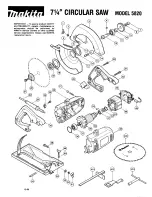
17
SYMPTOM
POSSIBLE CAUSES
SOLUTION
Cracks in core
Loss of tension
Blade flutters in cut as a result of losing
blade tension.
Blade specification is too hard for the
material being cut.
Core overheating.
Core overheating as a result of blade
spinning on arbor.
Core overheating from rubbing the ma-
terial being cut.
Unequal pressure at blade clamping
collars/flanges.
Blade is too hard for the material being
cut.
Tighten the blade shaft nut. Make sure
blade is running at proper speed and
that drive pin is functioning properly.
Use a softer bond/matrix to eliminate
stress.
Make certain blade RPM is correct.
Check water flow, distribution and lines.
Tighten the blade shaft nut. Make certain
the drive pin is functioning.
Properly align the saw to square cut.
Collars/flanges must be identical in
diameter and the recommended size.
Use a softer bond/matrix to reduce stress.
Blade wobbles
Blade is on a damaged or worn saw.
Worn collar.
Blade runs at an incorrect speed.
Collar/flange diameters are not identical.
Blade is bent as a result of dropping or
twisting.
Check for bad bearings, bent shaft, or
worn mounting arbor. Check collar/flange
to make sure they are clean, flat and of
correct diameter.
Set engine at proper RPM. Use proper
size blade collars/flanges.
DO NOT use bent blade. Contact blade
manufacturer.
Blade does not cut Blade is too hard for material being cut.
Blade has become dull. Blade does not
cut material it was specified for.
Select proper blade for material being
cut.
Sharpen by cutting on softer abrasive
material to expose diamonds. If conti-
nually sharpening, the blade is too hard
or the material being cut.
Break-in on the material to be cut. If it
does not dress itself, sharpen as you
would a dull blade.





































